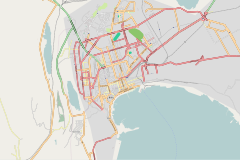Haji Bani Mosque
| Haji Bani Mosque | |
|---|---|
Azerbaijani: Hacı Bani məscidi | |
 | |
| Religion | |
| Affiliation | Islam |
| Location | |
| Location | Baku |
| Country | Azerbaijan |
| Geographic coordinates | 40°22′1″N 49°50′1″E / 40.36694°N 49.83361°E |
The Haji Bani Mosque (Azerbaijani: Hacı Bani məscidi) is one of the mosques of Azerbaijan, was built in the sixteenth century. It is located in Old City, Baku.
The mosque was designated as a nationally significant immovable historical and cultural monument by the decision No. 132 of the Cabinet of Azerbaijan on August 2, 2001.
About
[edit]The Haji Bani Mosque is situated near the Palace of the Shirvanshahs complex in Old City, Baku.[1] The mosque lacks a minaret and dome.[2] According to a short epigraphic inscription on the facade, the mosque was constructed in the sixteenth century by the architect Haji Bani,[3] and underwent major restoration[4][5] in the Islamic calendar year 1320.[a]
After the Soviet occupation in Azerbaijan, official measures to combat religion began in 1928. In December of the same year, the Azerbaijan Communist Party Central Committee transferred many mosques, churches, and synagogues to the balance of educational clubs for use in enlightening directions. If there were 3,000 mosques in Azerbaijan in 1917, by 1927, this number had reduced to 1,700, and by 1933, it was down to 17.[6]
After the restoration of Azerbaijan's independence, the mosque was included in the list of nationally significant immovable historical and cultural monuments by the decision No. 132 of the Cabinet of Azerbaijan on August 2, 2001.[7]
Architecture
[edit]In the mosque, directly opposite the entrance, there is a large-sized mihrab adorned with a stalactite design. During this restoration, renovation works were carried out, and a vestibule and a special section for women (shebistan) were added. The prayer hall is illuminated twofold thanks to the paired semicircular windows.[4] The restoration works maintained and preserved traditional architectural styles and motifs in both the interior and exterior.[3]The mosque's expressive silhouette, the foundation on a cubical base, the distinctive Absheron-type stone pointed dome, and the beautifully emphasized corner of the building in the direction of the street reflect the characteristic features of local architecture. [3][4]
See also
[edit]Notes
[edit]- ^ approximately 1902–03 AD
References
[edit]- ^ Fətullayev, Şamil (2013). Bakı memarları XIX əsrin sonu – XX əsrin əvvəlində (PDF) (in Azerbaijani) (Şərq-Qərb nəşriyyatı ed.). Bakı. p. 56. Archived (PDF) from the original on 2024-01-30. Retrieved 2024-01-30.
{{cite book}}: CS1 maint: location missing publisher (link) - ^ Azərbaycan Respublikası Məscidlərinin Ensiklopediyası (PDF) (in Azerbaijani). Bakı: Beynəlxalq Əlhuda. 2001. p. 50. ISBN 964-8121-59-1. Archived from the original (PDF) on 2021-07-23.
- ^ a b c Fətullayev, Şamil (2013). Bakının memarlıq ensiklopediyası. Baku: Şərq-Qərb nəşriyyatı. p. 90. ISBN 978-9952-32-020-6.
- ^ a b c "HАCI BANİ MƏSCİDİ" (in Azerbaijani). icherisheher.gov.az. Archived from the original on 2017-01-19. Retrieved 2014-09-29.
- ^ Fərhadoğlu, Kamil (2006). İçərişəhər (in Azerbaijani). Bakı: Ş-Q və Çinar-çap. p. 138.
- ^ Arif Yunusov (2004). Ислам в Азербайджане (PDF). Bakı: Zaman. p. 78. ISBN 9952-8052-0-9. Archived (PDF) from the original on 2023-07-05. Retrieved 2022-12-14.
- ^ "Azərbaycan Respublikası Nazirlər Kabinetinin 2001-ci il 2 avqust Tarixli 132 nömrəli qərarı ilə təsdiq edilmişdir" (PDF) (in Azerbaijani). mct.gov.az. 2001-08-02. Archived from the original (PDF) on 2021-07-07. Retrieved 2022-12-14.


